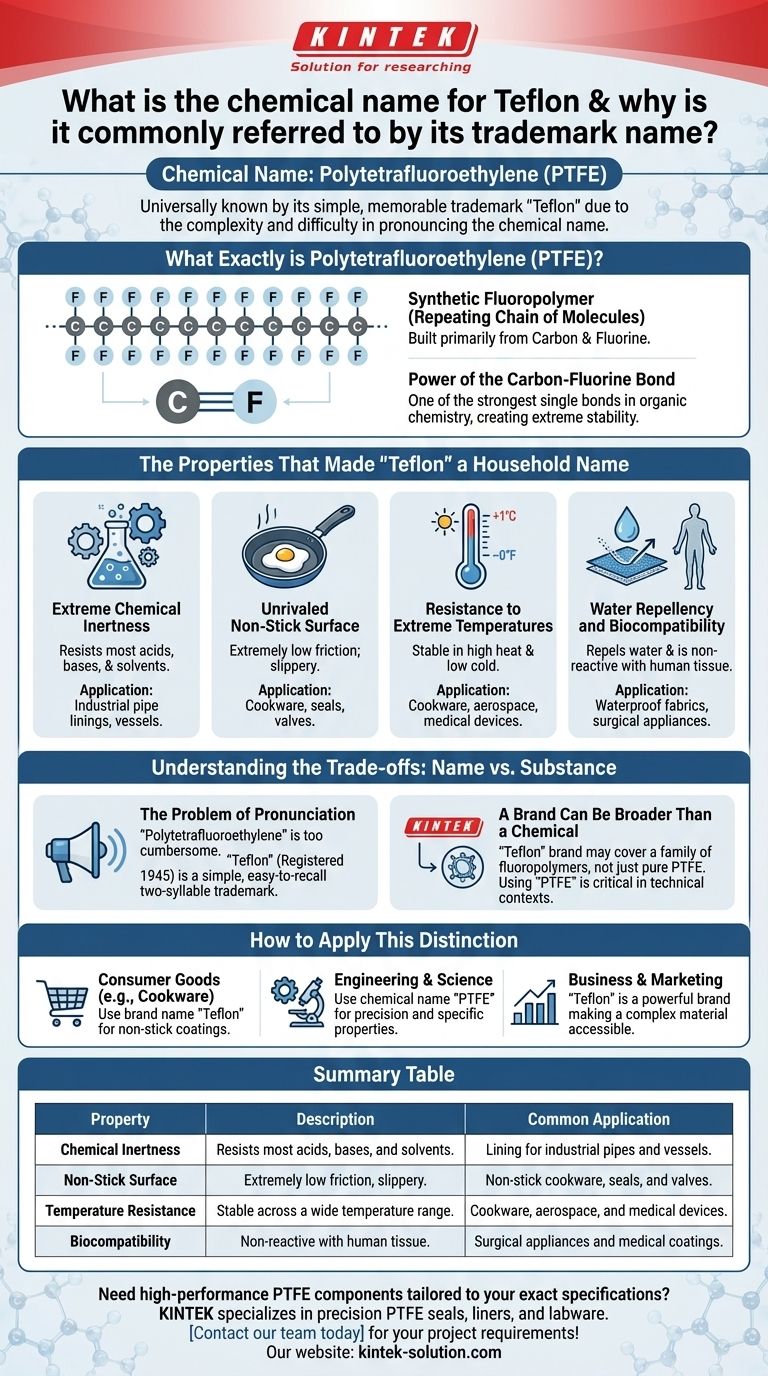The chemical name for Teflon is Polytetrafluoroethylene (PTFE). It is almost universally known by its trademark name because "Teflon" is a simple, memorable brand name, whereas its chemical name is complex and difficult for the general public and even many professionals to pronounce and recall.
The core reason "Teflon" eclipsed its chemical name, PTFE, is a classic case of marketing simplifying science. The brand name gave an accessible identity to a material whose unique properties—extreme non-reactivity and a virtually frictionless surface—were so revolutionary they permeated countless industries.

What Exactly is Polytetrafluoroethylene (PTFE)?
A Synthetic Fluoropolymer
Polytetrafluoroethylene is a synthetic polymer, a long, repeating chain of molecules. Specifically, it is a fluoropolymer, meaning its structure is built primarily from carbon and fluorine atoms.
The Power of the Carbon-Fluorine Bond
The unique characteristics of PTFE originate from the exceptionally strong bond between carbon and fluorine atoms. This bond is one of the strongest single bonds in organic chemistry, making the molecule incredibly stable and resistant to being broken apart by other chemicals.
The Properties That Made "Teflon" a Household Name
Extreme Chemical Inertness
Because of its strong molecular structure, PTFE is chemically inert, meaning it does not react with the vast majority of chemicals. It is highly resistant to most acids, bases, and solvents, which is why it's used to line pipes and vessels in demanding industrial environments, such as the early use in uranium enrichment plants.
Unrivaled Non-Stick Surface
This is Teflon's most famous property. Its surface has extremely low friction, making it one of the "slipperiest" materials known. This prevents other substances from sticking to it, a quality that revolutionized cookware and is also critical for creating anti-friction devices like seals and valves.
Resistance to Extreme Temperatures
PTFE remains stable across a wide range of temperatures. It can withstand high heat without degrading, which is essential for cookware, and it doesn't become brittle at very low temperatures, making it useful in various engineering applications.
Water Repellency and Biocompatibility
The material is also hydrophobic, meaning it repels water. This property is leveraged in waterproof and stain-resistant fabrics. Furthermore, because it is so unreactive, it is generally biocompatible, meaning it does not cause a reaction in the human body, allowing it to be used for coating medical and surgical appliances.
Understanding the Trade-offs: Name vs. Substance
The Problem of Pronunciation
For commercial and practical purposes, "Polytetrafluoroethylene" is simply too cumbersome. A simple, two-syllable trademark like "Teflon," registered in 1945, provided an easy way for engineers, marketers, and consumers to refer to the material.
A Brand Can Be Broader Than a Chemical
It's important to recognize that while "Teflon" is most famously associated with PTFE, the Teflon™ brand is owned by the Chemours Company and may be used to market a family of related fluoropolymer products, not just pure PTFE. Using the precise chemical name is critical in technical and scientific contexts.
Perception vs. Reality
The overwhelming success of Teflon in cookware means the public often associates the name with only that single application. This perception obscures its vital role in more critical fields, including aerospace, telecommunications, and medicine, where its other properties are paramount.
How to Apply This Distinction
Understanding the difference between the brand and the chemical is key to appreciating the material's true significance.
- If your primary focus is on consumer goods: You will almost always see the brand name "Teflon" used to signify a non-stick coating.
- If your primary focus is engineering or science: You must use the specific chemical name, PTFE, to avoid ambiguity and ensure you are referencing the correct material properties for your application.
- If your primary focus is on business and marketing: The story of Teflon serves as a perfect case study in how a powerful brand name can make a complex industrial material accessible to a global market.
Ultimately, the name "Teflon" became a household term because it gave a simple identity to a substance with extraordinarily versatile and valuable properties.
Summary Table:
| Property | Description | Common Application |
|---|---|---|
| Chemical Inertness | Resists most acids, bases, and solvents. | Lining for industrial pipes and vessels. |
| Non-Stick Surface | Extremely low friction, slippery. | Non-stick cookware, seals, and valves. |
| Temperature Resistance | Stable across a wide temperature range. | Cookware, aerospace, and medical devices. |
| Biocompatibility | Non-reactive with human tissue. | Surgical appliances and medical coatings. |
Need high-performance PTFE components tailored to your exact specifications? KINTEK specializes in manufacturing precision PTFE seals, liners, and labware for the semiconductor, medical, laboratory, and industrial sectors. Whether you require custom prototypes or high-volume production, our expertise ensures superior material performance for your critical applications. Contact our team today to discuss your project requirements!
Visual Guide

Related Products
- Custom PTFE Parts Manufacturer for Teflon Containers and Components
- Custom PTFE Parts Manufacturer for Teflon Parts and PTFE Tweezers
- Custom PTFE Teflon Balls for Advanced Industrial Applications
- Custom PTFE Square Trays for Industrial and Laboratory Use
- Custom PTFE Sleeves and Hollow Rods for Advanced Applications
People Also Ask
- When and by whom was PTFE discovered? A Tale of Accidental Innovation
- Why is dimensional stability a concern when machining PTFE? Ensure Accurate, Stable PTFE Components
- How is PTFE used in industrial processes? Maximize Safety and Efficiency
- What are some important physical property values for PTFE? Master Its Extreme Performance for Demanding Applications
- How does PTFE compare to other low-friction plastics like UHMW-PE and Nylon? A Guide to Material Selection



















